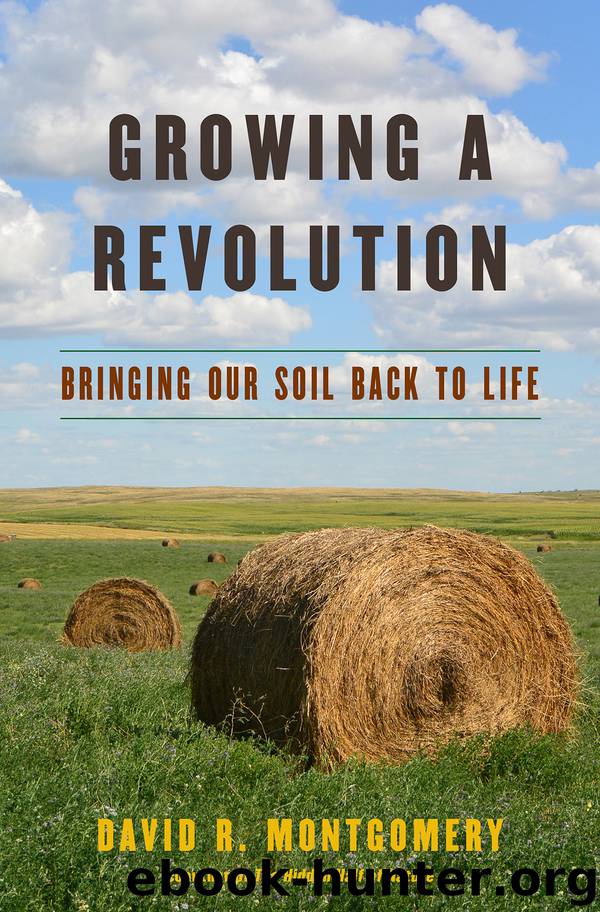Growing a Revolution by David R. Montgomery

Author:David R. Montgomery
Language: eng
Format: epub
Publisher: W. W. Norton & Company
A BETTER WAY
Back in 1993, the Natural Resources Conservation Service (NRCS) came out to assess Brown’s fields. They measured that it took an hour for half an inch of water to seep into the ground. At that point Brown was just starting the process of rebuilding his soil. In 2009, he got to see the fruits of his labor. That June, an intense storm cell dropped about thirteen inches of rain on Brown’s farm in under six hours. The next day his soil was wet, but he didn’t have any standing water, unlike his neighbor, who had lost his crop to erosion and the rainwater ponds that had sprouted in his fields. Two days after the storm, Brown could have driven just about anything across his own fields without rutting them up. Why the difference? On Brown’s fields all that rain had infiltrated into the ground.
When the NRCS came back and measured his fields again in 2011, eight inches could infiltrate in an hour. And by 2015 it took less than half a minute for two inches of water to sink in. More water infiltrating instead of running off translates into higher soil moisture and greater drought resilience.
Like many modern American farms, Brown Ranch is split into blocks scattered across the landscape. Brown owns almost 1,400 acres, but works a total of about 5,000 acres of low rolling hills with no more than 100 feet of relief to the horizon. His farm is smaller than average for his area, but he’s not trying to get bigger. He wants to shrink his farm and only work land he owns.
Brown grew up in Bismarck, several generations after his family settled in North Dakota in the 1880s. In 1991, he bought the home section of his in-laws’ farm. They had conventionally farmed it since 1956, with regular tillage, lots of fertilizer, and a small herd of cattle. The first year after Brown took over, good harvests still depended on a lot of fertilizer and pesticides. The next year, a friend advised him to go no-till to save time and effort. He thought that made sense as a way to save water, a huge concern since his land normally receives an average of just sixteen inches of precipitation a year—ten from rain and six from snow.
When Brown went no-till in 1993, his father-in-law was embarrassed and perplexed, convinced that “the more you worked the soil the better.” But as things went surprisingly well for the first few years, Brown diversified with hairy vetch and peas for livestock forage.
Then the day before harvest in 1995, Brown lost his entire wheat crop to hail. He barely managed to plant a quick cover crop for the cattle to graze. What do you do with hailed-out wheatland, especially if you’re a bit stubborn? Plant wheat again, like Brown did in 1996. Then hail returned for a second round. Brown had to take an off-farm job to pay the bills.
The next year, 1997, was very dry. He didn’t harvest a thing, and nobody else around did either.
Download
This site does not store any files on its server. We only index and link to content provided by other sites. Please contact the content providers to delete copyright contents if any and email us, we'll remove relevant links or contents immediately.
| Anatomy | Animals |
| Bacteriology | Biochemistry |
| Bioelectricity | Bioinformatics |
| Biology | Biophysics |
| Biotechnology | Botany |
| Ecology | Genetics |
| Paleontology | Plants |
| Taxonomic Classification | Zoology |
Sapiens: A Brief History of Humankind by Yuval Noah Harari(14320)
The Tidewater Tales by John Barth(12626)
Mastermind: How to Think Like Sherlock Holmes by Maria Konnikova(7278)
Do No Harm Stories of Life, Death and Brain Surgery by Henry Marsh(6905)
The Thirst by Nesbo Jo(6877)
Why We Sleep: Unlocking the Power of Sleep and Dreams by Matthew Walker(6655)
Life 3.0: Being Human in the Age of Artificial Intelligence by Tegmark Max(5516)
Sapiens by Yuval Noah Harari(5322)
The Longevity Diet by Valter Longo(5040)
The Body: A Guide for Occupants by Bill Bryson(5027)
The Rules Do Not Apply by Ariel Levy(4910)
The Immortal Life of Henrietta Lacks by Rebecca Skloot(4550)
Animal Frequency by Melissa Alvarez(4428)
Why We Sleep by Matthew Walker(4394)
The Hacking of the American Mind by Robert H. Lustig(4338)
Yoga Anatomy by Kaminoff Leslie(4332)
All Creatures Great and Small by James Herriot(4271)
Double Down (Diary of a Wimpy Kid Book 11) by Jeff Kinney(4240)
Embedded Programming with Modern C++ Cookbook by Igor Viarheichyk(4141)
